Ventilation in a stretch ceiling: why do you need + subtleties of arrangement
Stretch cloths are a popular type of arrangement of suspended ceiling ceilings. They are widely used in public institutions, public institutions, residential buildings and apartments, in those areas in which fire safety standards allow. As with any suspended structure, ventilation in a suspended ceiling is one of the most important engineering structures.
Unfortunately, there are many companies that can beautifully mount a spectacular cover, but only after many installers do the problems with the indoor climate begin, due to the illiteracy of the installation of the ventilation system
How to control the creation of the correct air exchange, what calculations should be made, which scheme to choose and what norms exist in apartments, where it is impossible to equip new channels in the supporting structures? There are so many questions, but we are ready to answer all. We will talk about the design options and design features of the ventilation system of suspended ceilings.
The content of the article:
Varieties of ventilation with suspended ceilings
As well as for any other design, there are 2 main types of air exchange for stretch ceilings.
It:
- Natural - involves the installation of simple elements for ventilation (air ducts and ventilation shafts) or their absence in order to create a natural movement of the air flow.
- Forced- when the design provides for a fan to create a forced draft
In general, in the arrangement of ventilation in rooms with such a ceiling covering, there should not be a question about how to provide ventilation of a stretch ceiling.
Rather, it is relevant how to integrate a ventilation system into the suspended ceiling so that the canvas does not interfere with air exchange and releases pressure between the ceiling space and the room.
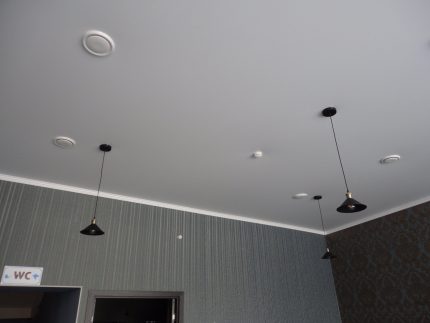
That is, initially it is necessary to equip a high-quality system, which should be in every house, and only then adjust your suspended structure for it, and not vice versa. You are creating a microclimate not for the ceiling, but for your health, because the canvases themselves do not need much fresh air.
Natural air exchange and ventilation grilles
As you know, there are different types of ceiling paintings and one of them is perforated. This is a special type of release of the material itself. PVC, fabric - not important. The bottom line is that there are holes on the canvas. They can be randomly arranged or form a single pattern.
Their purpose is initially design. However, in most cases, they also do not interfere with healthy air circulation. Of course, not in all forms, it depends on the location and size of the perforation, but very often thanks to it, the arrangement of additional air exchange devices under the canvas is not required.
But such a canvas is expensive and very difficult to masterfully beat in a design sense. Most often you have to think over a system for ordinary paintings.
If the room already has working ventilation, there will be no problems with ensuring air circulation in the ceiling space. Simply install the ventilation grilles or diffusers into the tension web.
There is nothing complicated. And the process itself will not take much time.

It is enough to put special tread rings on the glue, cut holes for the devices and install them.
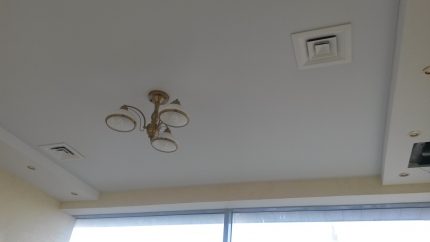
It should be noted right away that they do not spoil the appearance of the ceiling, since they are quite compact, and in addition, they look pretty decent in appearance, remind ordinary ceiling lamps. In addition, you can choose almost any color that is most suitable for the shade of the canvas.
Arrangement of artificial ventilation
If the ventilation hood or shaft is located in the ceiling space of the bathroom, toilet or kitchen and the suspended structure naturally closes them, it is necessary to install the hood through the canvas of the stretch ceiling using special designs that imply the use of a forced ventilation method.
Through the existing ventilation shafts, it is also possible to arrange air exchange in rooms that are not equipped with a circulation system, but that need it.
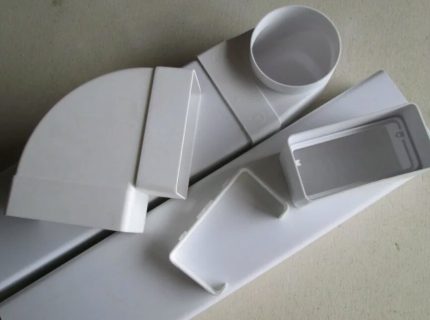
Experts say that in rooms with low ceilings - less than 2.65 m high, it is not practical to install ceiling fans. If we are talking about a bathroom with such a height, it is best to think about installing a hood.
Initially, it is necessary to carry out all the calculations and consider the coherence of creating forced air exchange. And then pick up the material from which the structure will be made.
Air duct can be made of:
- drywall;
- corrugated pipe;
- plastic items.
The latter option is the most convenient and fastest. Consider the usual forced air exchange with the installation of the fan in stages.
Stage number 1 - fixing ducts
The duct is carefully fixed directly to the ceiling surface or to pre-installed suspensions. It is very important that the design is absolutely airtight, otherwise an area of negative pressure will appear and the canvas will “suck” to the base.
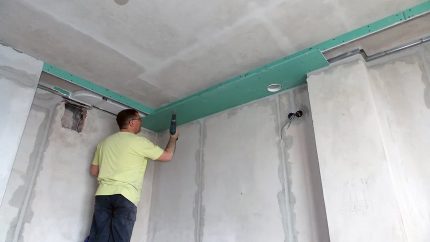
After air ducts are fixed, you need to output all the necessary electrical wires.
Stage number 2 - equip a place for a fan
After installing the air duct, it is necessary to provide a mortgage for the fan. Usually it is made of plywood. The mortgage is attached to the base ceiling with suspensions.
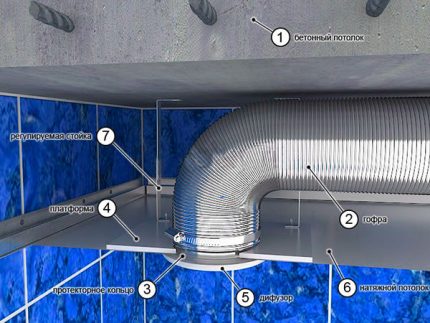
Stage number 3 - installation of the tension web
Next, the tension web itself is installed, but very carefully so as not to damage the surface. When the stretch ceiling is installed, we need to install the tread ring in the place of attachment of the mortgage.
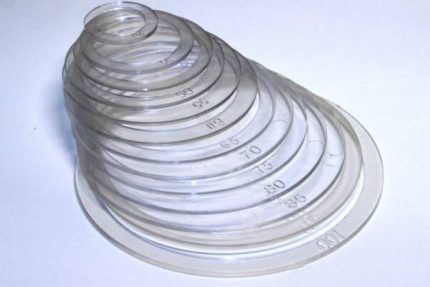
Stage number 4 - make holes for the duct
After the ring is firmly fixed, you need to carefully cut the hole for the duct.
This is done using an ordinary clerical knife.
Stage number 5 - connect the fan
Then you can connect the fan. To do this, it must be firmly inserted into the ventilation duct and fixed. Wires are routed through openings in the enclosure and connected via terminals.
Stage 6 - installation of the ventilation grill
Install on top of our design ventilation grill.
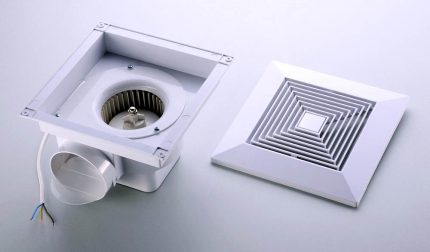
From the opposite angle of the room system installed, you need to install a diffuser or ventilation grid.
You can read more detailed installation instructions for the exhaust fan. here.
Stretch ceiling hood
In kitchens, a hood is usually present. And from this device, engineering structures are drawn that often annoy the owners with their unaesthetic. However, the pipe from the hood can also be hidden in a stretch ceiling and we will now tell you how.
Instead of corrugated pipes, which are usually equipped with ventilation systems, it is best to use special plastic ducts not round, but rectangular section 55 × 110 mm. They are able to fit as close as possible to the base, which will provide the possibility of minimal lowering of the level of the frame for a stretch ceiling.
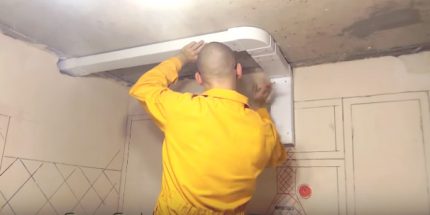
Be careful, again, all joints must be carefully sealed, and wiring laid in advance, even before mounting the canvas itself.
Another important detail - if the pipeline from the hood passes through other rooms and you want to combine the ventilation system of these rooms through it, be sure to install diffusers with non-return valves so that exhaust air from the kitchen is not drawn into all rooms.
So, you installed the ducts from the ventilation shafts. Now you need to equip the pipe from the hood in the surface of the stretch ceiling. To combine the duct you mounted with the hood, you should use a rectangular adapter on the round corrugation from the device itself.

A hole is made in the canvas of a suitable diameter for its connection, communications are connected. Well, at the last stage, they check the operation of the exhaust equipment.
Nuances of arranging the ventilation of a stretch ceiling
Before installing all systems, it is necessary to prepare the surface. In general, in technology, they are mandatory during the finishing work of this type of technology. However, most often they are ignored, believing that the suspension structure is designed to hide all the flaws.
So, first of all, you need to take care of sealing any cracks and joints. Naturally, these are cold bridges that provoke condensation. For this, it is also recommended to carry out thermal insulation. This is true for residents of private houses and the upper floors of the MKD with an uninsulated attic space.
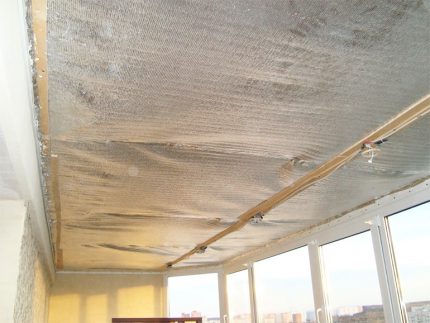
Next, it is worth taking care of strengthening the structure. With a mechanical ventilation system, a solid base for wiring is very important.
And finally, the last - rodents like to run around the stretch ceiling. They can easily bite the electrical wiring of forced ventilation or get into the air ducts and die there, creating a stench instead of fresh air for the owners. Therefore, it is important to exclude all variants of rodents getting into the ceiling space.
Cons of the ventilation system of suspended ceilings
Manufacturers of stretch linens are very fond of boasting about the degree of stretching of their linens in case of flooding by neighbors from above or leaking roof. Of course, for the paintings themselves, this situation will be stalemate, but at least you will save repairs and furniture if the water does not pour down and is delayed by a stretch ceiling.
So, the installation of additional ventilation holes reduces the tightness of the structure and, accordingly, increases the risk of leakage in these places.
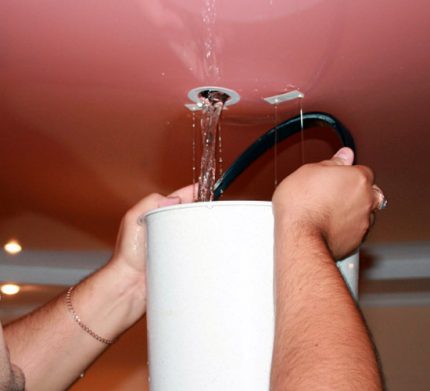
When arranging ventilation, accurate individual calculations are nevertheless necessary, which are carried out directly at the facility. Therefore, any instructions can be considered only conditional guidance.
Another important point is the problem of servicing the duct. If there is any problem with the system, you will have to remove the entire canvas to fix the breakage.
Conclusions and useful video on the topic
Installation of ventilation grilles in the suspended ceiling:
We talked about installing ventilation in a suspended ceiling with our own hands, as you can see, there is practically nothing complicated about it. However, one should take into account the fact that, for example, forced ventilation should be made at the first stage of installation of the tension web. And even the usual insert of ventilation grilles, although it seems simple, can lead to damage to the decorative ceiling. Therefore, you should still entrust this to professionals.
Do you have stretch ceilings at home? Do you plan to equip them with ventilation and what option are you considering? Or maybe you encountered some difficulties during the installation of ventilation in a suspended ceiling? Share your experiences in the comments and ask questions about the topic of the article.

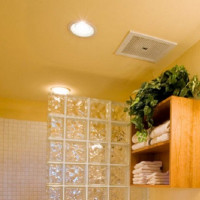 Ventilation in the bathroom in the ceiling: arrangement features + installation instructions for the fan
Ventilation in the bathroom in the ceiling: arrangement features + installation instructions for the fan  Is forced ventilation in the bathroom necessary: norms and stages of arranging efficient air exchange
Is forced ventilation in the bathroom necessary: norms and stages of arranging efficient air exchange 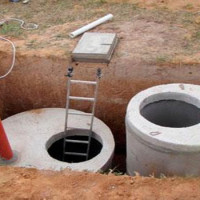 Ventilation of a septic tank in a private house: is it needed + tips for arranging
Ventilation of a septic tank in a private house: is it needed + tips for arranging  Basement ventilation in a private house: the best ways to arrange proper air exchange
Basement ventilation in a private house: the best ways to arrange proper air exchange  Inspection pit ventilation in a garage: specifics of arranging an air exchange system
Inspection pit ventilation in a garage: specifics of arranging an air exchange system  Roof ventilation for metal: an overview of options and nuances of arrangement
Roof ventilation for metal: an overview of options and nuances of arrangement  How much does it cost to connect gas to a private house: the price of organizing gas supply
How much does it cost to connect gas to a private house: the price of organizing gas supply  The best washing machines with dryer: model rating and customer tips
The best washing machines with dryer: model rating and customer tips  What is the color temperature of light and the nuances of choosing the temperature of the lamps to suit your needs
What is the color temperature of light and the nuances of choosing the temperature of the lamps to suit your needs  Replacement of a geyser in an apartment: replacement paperwork + basic norms and requirements
Replacement of a geyser in an apartment: replacement paperwork + basic norms and requirements